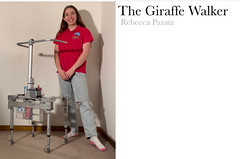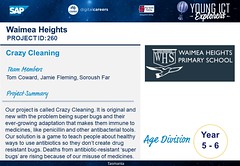Nationals Finals 2021
Year 3 – 4
First Place
Medibot 2.0
Sol Crisp
West Pymble Public School
Last year I created a project called Medibot, a pill reminder system based on voice recognition technology and entered it into YICTE 2020. This year I am building on Medibot to create Medibot 2.0. Medibot 2.0 is a version of Medibot that will have enhanced features such as: allowing the career to enter the pills to take, making it available on a smaller and cheaper device and providing a way to record if the pills were taken.
Second Place
Maths Pet
Lachlan Bandidt
Good News Lutheran School
Some kids find it hard to remember their times tables.
Cambridge University says that knowing your times tables is needed in order to solve higher level problems and memorisation of times tables frees up working memory to be used on other tasks. They suggest that computer-based practice is more effective, perhaps because students are more motivated and that timing tests promotes faster recall by students.
The Maths Pet makes it fun and easy to practice times tables. Students can choose their difficulty level and test themselves against the built-in timer. When they get an answer correct, the green LED lights up. When they get an answer wrong, the red LED turns on.
Third Place
Rubbish bot
Maddison Bushell, Darcey Forrester, Stella Stuart, Taylor Brown
Perth College
People always leave their waste in parks and do not bother to pick it up. Pollution is having a direct impact on sensitive species or habitats. In our local park we come across loads of rubbish. The Rubbish Bot will detect, collect and then put the rubbish in the right coloured recycle bin. For example, bottles in the recycle bin. The Rubbish Bot is solar powered which makes the machine operate during daylight hours. The Rubbish Bot has a sensor in the front to detect rubbish. When it has located rubbish. The Rubbish Bot also senses when it is at full capacity & returns to the bin storage to empty its load. At night time, the Rubbish Bot connects to a park bin for safe keeping whilst it stores excess solar energy in its battery pack. The Rubbish Bot has a home detector which means it’ll only stay in its park.
Year 5 – 6
First Place
Stretchy 365
Lucinda Coyle, Lincoln Rucker
St Joseph’s Bardon
Stretchy 365’s main problem to solve was the concern of asthma and the fact that asthma attacks can come on with no warning and can put many asthmatics into a hospital bed. Asthma effects lots of people we know, and they live with it everyday, knowing the harm it can do to them. We used a micro-bit detect the amount of tension in the stretch sensor and send the data to the micro bit. If the tension was too shallow, indicating that and asthma attack was coming on, it will light up and beep. The stretch sensor goes around you upper stomach (near your lungs) and the micro bit and holder sits to the front or side. We came across many problems while building prototypes, some were the fact the stretch reading was inaccurate another was the code wasn’t ordered properly and also sometimes paring the micro bit and downloading the code could be problematic. But many of the problem we faced we managed to fix
Second Place
HI.LED
Elizabeth Townsley, Miette Egerton-Warburton
St Hilda’s Anglican School for Girls
The Year 6 Community Service students at our school help with a Breakfast Club at Mosman Park Primary School. Some of the students are hearing impaired. We learned from their teacher that they find their drumming lessons particularly challenging because they can’t hear if they are playing correctly. We have invented the HI.LED to help them enjoy their drumming lessons and make progress. We have used an Arduino, 4 breadboards, LEDS, microphone, text display screen, wires, resistors and code to give the students feedback on their drumming via different coloured LEDs and text.
Third Place
Rubbish Sorter
Annabelle Nakhakes
Canberra Girls Grammar School
My project is about sorting rubbish and sorting it correctly. I decided to do this because I am sad about how tons of rubbish is dumped in the sea everyday so I wanted to change it. So I have decided to build a rubbish sorter, which will sort rubbish and it will tell people which bin the rubbish goes in. I wanted to build a bin that can “recognise” pictures of different things like cars and cups. My goal is to teach people about the different types of rubbish and where it goes. For my project I used machine learning and supervised learning to teach the computer the different types of rubbish. Supervised learning is when we give data that is labelled/what it is. Unsupervised learning is when we don’t give labelled data and the machine has to guess.
Year 7 – 8
First Place
BRAID – Bushfire Recovery AI Drone
Chengyun Xu, Nabhanya Gupta, Vinay Raghavan, Sanjay Parappat
Haileybury
Our project for Digitech Explorers is a drone which utilizes artificial intelligence to analyze acreage and provides telemetry on what it has observed. Our drone will work on CV (Computer Vision) and a Raspberry Pi. This drone will enable the surveying of agricultural premises for harvesting purposes, as well as for the examination of land for lack of water or dried leaf patches. This project, we believe, is significant as it allows for the efficiency of agriculture to be increased by analyzing large areas of land quickly and providing information on progress, enabling targeted focus to struggling areas and more accurate harvesting of plants. It will also reduce the burden of people who would otherwise have to move over hectares of acreage to examine the growth of crops. Furthermore, the measurements of overall dryness could be used to assist in preventing bushfires. Additionally, the telemetry from our drone could identify weed distribution in acreage
Second Place
SIDS Saviour
Mia George, Sophie Morgan, Rani Cirkovic, Joyan Zho
St Hilda’s Anglican School for Girls
The SIDS Saviour device enables parents to monitor the baby for possible suffocation from rolling by informing the parents via an alarm. The small device is attached to the clothing of the baby as well as in the mattress. When the two devices make contact, it sends an alarm to a mobile phone.
Third Place
Cybear
Harmony Fisher, Emily Hughes, Janice Judge, Aaliyah Bazzara
Mansfield State High School
Cybear is a mobile app designed to improve mental health and wellbeing during lockdown by staying connected with people around the world. The app contains fun, collaborative projects on Happy Feed so people can help those who are experiencing loneliness. We know that keeping in touch is a vital aspect to maintain good mental health because friends boost your happiness and self esteem. ‘Donations’ allow users to donate money to our app to help charities with COVID-19. With a simple touch of a button, users can transform the lives of others around the world to make them that little bit happier.The app has been developed in code.org’s App Lab which allows you to switch between block code and javascript.
Year 9 – 10
First Place
The Giraffe Walker
Rebecca Paratz
Bailik College
I invented and developed The Giraffe Walker to address one of society’s significant issues- the incidence of falls by the elderly and the consequent injury, loss of confidence, self-esteem and independence.“The Giraffe Walker is a self-levelling, intelligent, All-terrain Walker which allows the elderly to safely travel up and downstairs and traverse uneven surfaces.” Currently, one in four elderly people fall per year and in the US every 19 minutes an elderly person dies due to their fall. These are outrageous statistics – and the basis of my invention.
The Giraffe Walker’s auto stabilising design means that the elderly will have secure stability regardless of the terrain. The Giraffe Walker’s legs self-adjust their height to ensure that the walker is constantly flat and balanced. Thus, the walker can go anywhere needed – stairs, sand, rock, concrete, carpet, etc.
Second Place
Firefighter
Caleb Tang
Prince Alfred College
My project is a fully wireless automated firefighting aircraft. The aerial vehicle uses a custom trained machine learning model to completely autonomously operate using Artificial Intelligence. ‘Firefighter’ utilises an onboard camera to stream the surroundings of the fire, detect fire and follow fire in real-time as well as multiple sensors to alert the driver of what is going on around it and to track the conditions of the fire.
Third Place
Prosthetic Hand Using Muscle Sensor
Shay Brokensha
St Andrews Lutheran College
The project that I have created could help many amputees. While some adjustments would have to be made for a real amputee to use it (instead of mounting it on wood I could have made a sleeve) the actual technological side is working flawlessly. In this project I was able to use the MyoWare Muscle Sensor to detect electrical signals in my forearm when my hand is clenched (in a real amputee they can think about tensing their hand and it will do the same thing). From that I then controlled three servo motors which pulled fishing wire to close the fingers on the 3d printed hand (fishing wire acted as tendons while servo motors acted as muscles). If the servo motor wasn’t pulling the fishing wire the fingers would open back up due to a piece of elastic on the back of the fingers. Ultimately if an actual amputee used it they would be able to pick up and put down things, giving the person more freedom.
Year 11 – 12
First Place
SatAlight
Dylan Nguyen
St Andrew’s Cathedral School
SatAlight is an artificial intelligence system built to rapidly assess the bush fire proneness of land areas throughout New South Wales. It uses satellite imagery to accurately classify vegetation areas based on their bush fire risk. Its intended use is to inform area managers and residents about the bush fire hazard of their local areas, thus helping these key stakeholders to be prepared for potential bush fire activity. SatAlight was presented to the NSW Rural Fire Service, who are now looking to implement it in their land mapping processes.
Second Place
DAS – Discord Algebra System
Ray Lin
Melbourne High School
The Discord Algebra System (DAS) is a Discord bot with the purpose of providing the capabilities of displaying, solving, deriving, integrating, and graphing equations in a quick and accurate manner to assist in the learning of mathematics directly inside a Discord server to the great benefit of students, teachers, and tutors. From the comfort of users’ own private servers, they will be able to visually represent calculations within a popular social media platform without the hassle of opening other applications or taking screenshots of physical material.
Third Place
EducationForAll
Jasmine Jared
Rangitoto College
A digital outcome, in the form of a multi-page web portal (e.g. has both an informational page for teachers to monitor students within their class and an informational student page for students to complete lessons/taskwork so that the solution appeals to different demographics), which is aimed at positively impacting impoverished students through free education across a range of subjects. This is done by teachers logging in and submitting educational videos to be indexed by EducationForAll’s AI. Once these videos are indexed, the students can perform a unique deep search. Compared to competitor’s video libraries which only allow for users to search for a specific video against their descriptions, EducationForAll allows any student to search for videos against their audible content.



